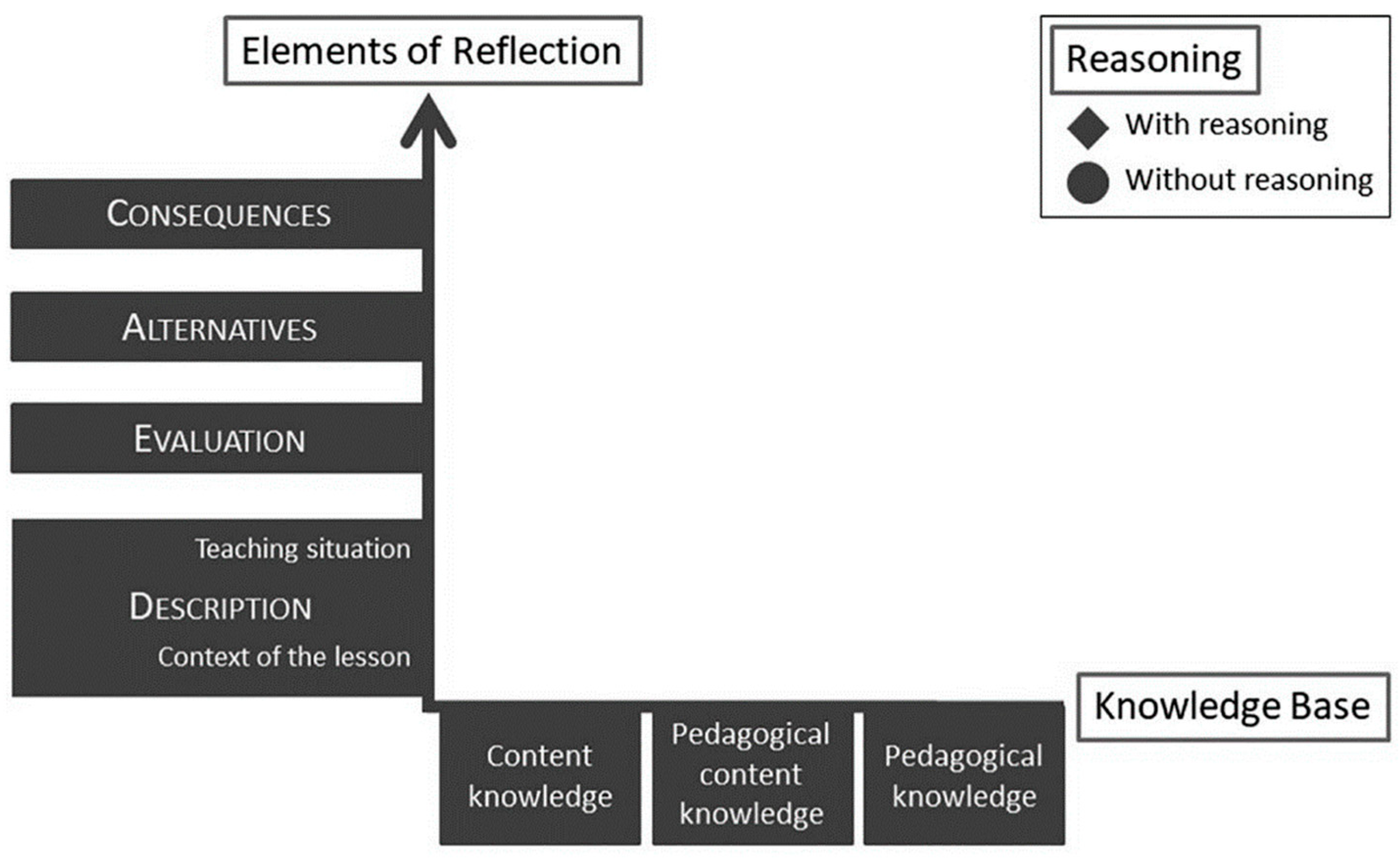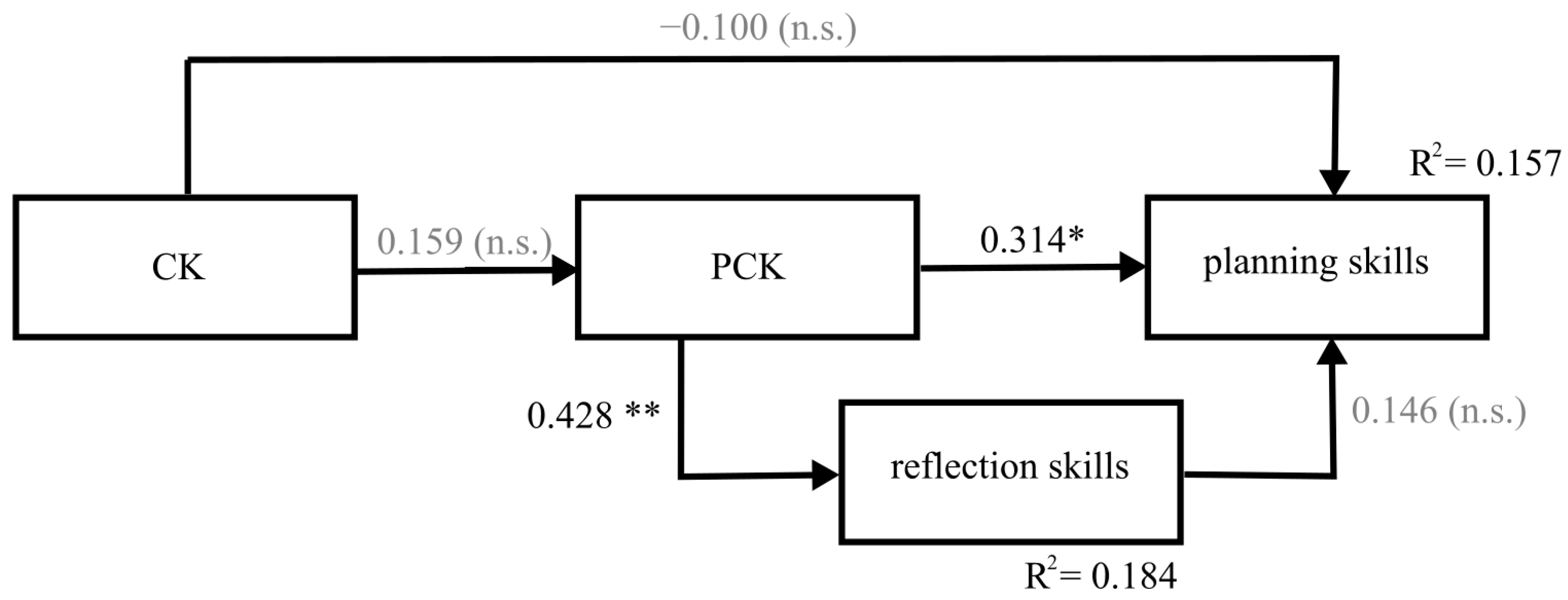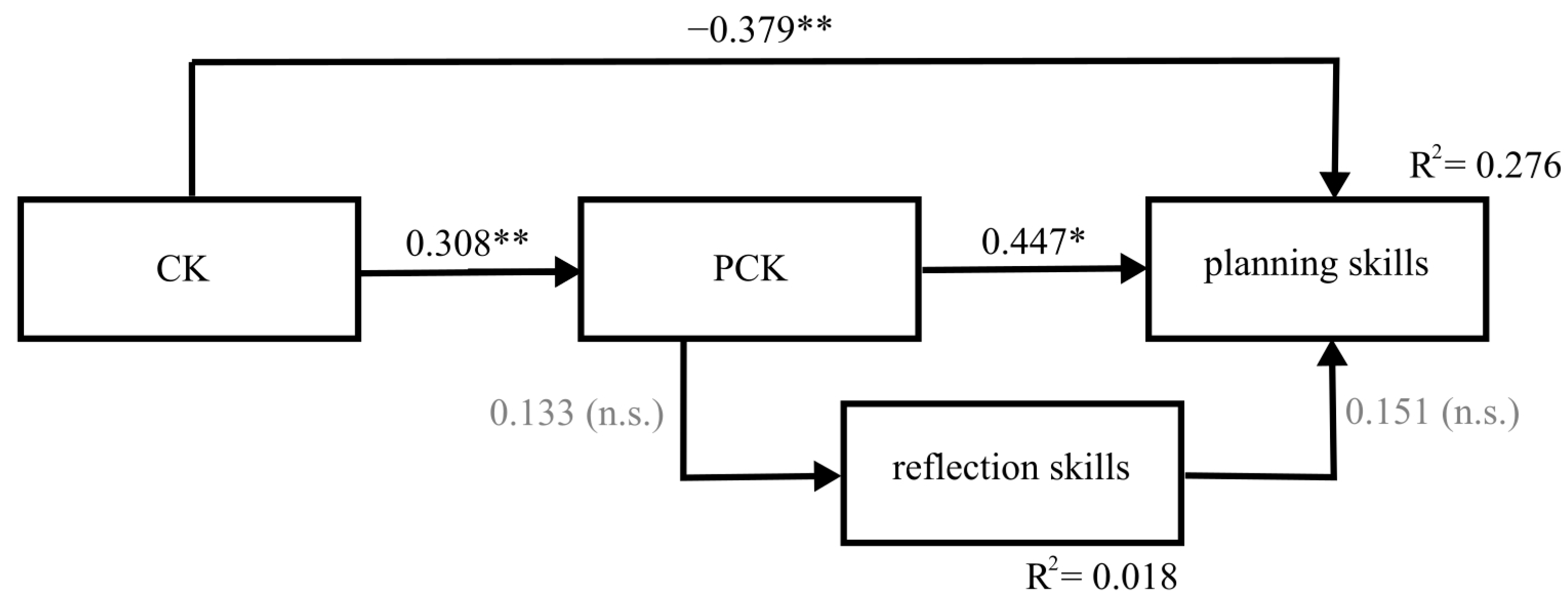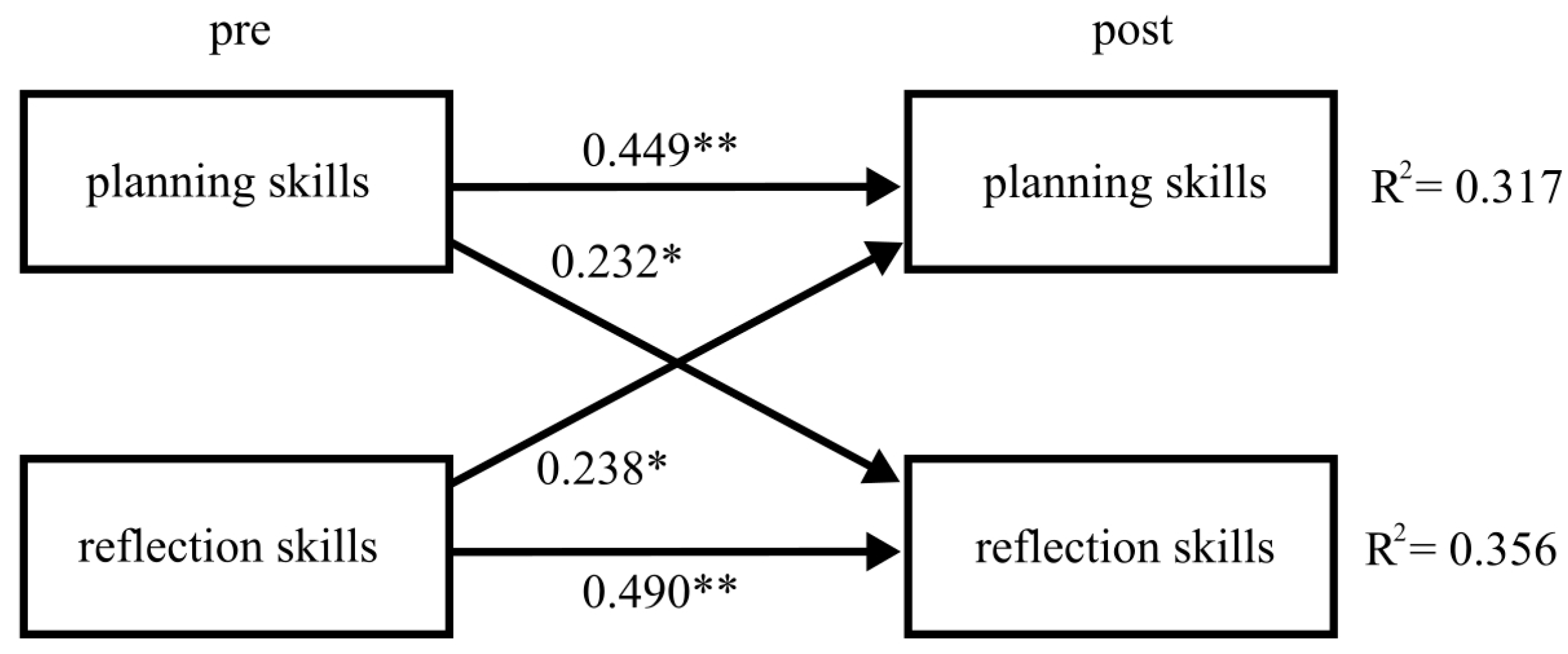Learning to Plan by Learning to Reflect?—Exploring Relations between Professional Knowledge, Reflection Skills, and Planning Skills of Preservice Physics Teachers in a One-Semester Field Experience
Abstract
:1. Introduction
2. Background
2.1. Relations between Physics Teachers’ Professional Knowledge and Professional Skills
2.2. Physics Teachers’ Reflection Skills
2.3. Physics Teachers’ Lesson Planning Skills
2.4. Relations between Physics Teachers’ Reflection and Planning Skills
3. Methods
3.1. Research Goals and Assumptions
3.2. Design and Context of the Study
3.3. Sample
3.4. Instruments
3.4.1. Content Knowledge
3.4.2. Pedagogical Content Knowledge
3.4.3. Reflection Skills
3.4.4. Planning Skills
- Physical content and correctness
- Elementarization
- Presentation and consideration of students’ perspectives
- Reachability of learning objectives
- Presentation and use of experiments
- Presentation and use of tasks or questions
- Use of examples and contexts
3.5. Data Analysis
4. Results
4.1. Descriptive Analyses of PCK, CK, Reflection, and Planning Skills before and after the Field Experience
4.2. Relations between PCK, CK, Reflection Skills, and Planning Skills before and after the Field Experience
5. Discussion
6. Conclusions
Author Contributions
Funding
Institutional Review Board Statement
Informed Consent Statement
Data Availability Statement
Acknowledgments
Conflicts of Interest
References
- Baumert, J.; Kunter, M. The COACTIV model of teachers’ professional competence. In Cognitive Activation in the Mathematics Classroom and Professional Competence of Teachers; Kunter, M., Baumert, J., Blum, W., Klusmann, U., Krauss, S., Neubrand, M., Eds.; Springer: Boston, MA, USA, 2013; pp. 25–48. [Google Scholar] [CrossRef]
- Cohen, E.; Hoz, R.; Kaplan, H. The practicum in preservice teacher education: A review of empirical studies. Teach. Educ. 2013, 24, 345–380. [Google Scholar] [CrossRef]
- Besa, K.S.; Büdcher, M. Empirical evidence on field experiences in teacher education: A review of the research base. In Schulpraktika in der Lehrerbildung: Theoretische Grundlagen, Konzeptionen, Prozesse und Effekte; Arnold, K.H., Gröschner, A., Hascher, T., Eds.; Waxmann: Münster, Germany, 2014; pp. 129–146. [Google Scholar]
- Holtz, P.; Gnambs, T. The improvement of student teachers’ instructional quality during a 15-week field experience: A latent multimethod change analysis. High. Educ. 2017, 74, 669–685. [Google Scholar] [CrossRef]
- Zeichner, K. Rethinking the connections between campus courses and field experiences in college-and university-based teacher education. J. Teach. Educ. 2010, 61, 89–99. [Google Scholar] [CrossRef] [Green Version]
- Kulgemeyer, C.; Borowski, A.; Buschhüter, D.; Enkrott, P.; Kempin, M.; Reinhold, P.; Riese, J.; Schecker, H.; Schröder, J.; Vogelsang, C. Professional knowledge affects action-related skills: The development of preservice physics teachers’ explaining skills during a field experience. J. Res. Sci. Teach. 2020, 57, 1554–1582. [Google Scholar] [CrossRef]
- Kulgemeyer, C.; Kempin, M.; Weißbach, A.; Borowski, A.; Buschhüter, D.; Enkrott, P.; Reinhold, P.; Riese, J.; Schecker, H.; Schröder, J.; et al. Exploring the impact of pre-service science teachers’ reflection skills on the development of professional knowledge during a field experience. Int. J. Sci. Educ. 2021, 43, 3035–3057. [Google Scholar] [CrossRef]
- Loughran, J.J. Developing Reflective Practice. Learning about Teaching and Learning; Falmer Press: London, UK, 2006. [Google Scholar]
- Ruys, I.; Van Keer, H.; Aelterman, A. Examining pre-service teacher competence in lesson planning pertaining to collaborative learning. J. Curric. Stud. 2012, 44, 349–379. [Google Scholar] [CrossRef]
- Sorge, S.; Stender, A.; Neumann, K. The development of science teachers’ professional competence. In Repositioning Pedagogical Content Knowledge in Teachers’ Knowledge for Teaching Science; Hume, A., Cooper, R., Borowski, A., Eds.; Springer: Singapore, 2019; pp. 115–166. [Google Scholar] [CrossRef]
- Carlson, J.; Daehler, K.R.; Alonzo, A.C.; Barendsen, E.; Berry, A.; Borowski, A.; Carpendale, J.; Chan, K.K.H.; Cooper, R.; Friedrichsen, P.; et al. The refined consensus model of pedagogical content knowledge in science education. In Repositioning Pedagogical Content Knowledge in Teachers’ Knowledge for Teaching Science; Hume, A., Cooper, R., Borowski, A., Eds.; Springer: Singapore, 2019; pp. 77–84. [Google Scholar] [CrossRef]
- Grossman, P.; Hammerness, K.; McDonald, M. Redefining teaching, re-imagining teacher education. Teach. Teach. Theory Pract. 2009, 15, 273–289. [Google Scholar] [CrossRef]
- Matsumoto-Royo, K.; Ramírez-Montoya, M.S. Core practices in practice-based teacher education: A systematic literature review of its teaching and assessment process. Stud. Educ. Eval. 2021, 70, 101047. [Google Scholar] [CrossRef]
- Abell, S. Research on science teachers’ knowledge. In Handbook of Research on Science Education; Abell, S., Lederman, N., Eds.; Lawrence Erlbaum Associates: Mahwah, NJ, USA, 2007; pp. 1105–1149. [Google Scholar]
- Fischer, H.; Borowski, A.; Tepner, O. Research on science teachers’ knowledge. In Second International Handbook of Science Education; Fraser, B., Tobin, K., McRobbie, C., Eds.; Springer: Dordrecht, The Netherlands, 2012; pp. 435–448. [Google Scholar]
- Fischer, H.; Neumann, K.; Labudde, P.; Viiri, J. Quality of Instruction in Physics. Comparing Finland, Germany and Switzerland; Waxmann: Münster, Germany, 2014. [Google Scholar]
- Shulman, L. Knowledge and teaching: Foundations of the new reform. Harv. Educ. Rev. 1987, 57, 1–22. [Google Scholar] [CrossRef]
- Vogelsang, C.; Borowski, A.; Buschhüter, D.; Enkrott, P.; Kempin, M.; Kulgemeyer, C.; Reinhold, P.; Riese, J.; Schecker, H.; Schröder, J. Entwicklung von Professionswissen und Unterrichtsperformanz im Lehramtsstudium Physik—Analysen zu valider Testwertinterpretation [Development of professional knowledge and performance in academic physics teacher education]. Z. Für Pädagogik 2019, 64, 473–491. [Google Scholar] [CrossRef]
- Lee, E.; Luft, J.A. Experienced secondary science teachers’ representation of pedagogical content knowledge. Int. J. Sci. Educ. 2008, 30, 1343–1363. [Google Scholar] [CrossRef]
- Gramzow, Y.; Riese, J.; Reinhold, P. Modellierung fachdidaktischen Wissens angehender Physiklehrkräfte [Modelling prospective teachers’ knowledge of physics education]. Zeitschrift für Didaktik der Naturwissenschaften 2013, 19, 7–30. [Google Scholar]
- Alonzo, A.; Berry, A.; Nilsson, P. Unpacking the complexity of science teachers’ PCK in action: Enacted and personal PCK. In Repositioning Pedagogical Content Knowledge in Teachers’ Knowledge for Teaching Science; Hume, A., Cooper, R., Borowski, A., Eds.; Springer: Singapore, 2019; pp. 93–116. [Google Scholar] [CrossRef]
- Blömeke, S.; Gustafsson, J.; Shavelson, R. Beyond dichotomies. Competence viewed as a continuum. Z. Für Psychol. 2015, 223, 3–16. [Google Scholar] [CrossRef]
- Cauet, E.; Liepertz, S.; Kirschner, S.; Borowski, A.; Fischer, H.E. Does it matter what we measure? Domain-specific professional knowledge of physics teachers. Schweiz. Z. Für Bild. 2015, 37, 462–479. [Google Scholar] [CrossRef]
- Liepertz, S.; Borowski, A. Testing the consensus model: Relationships among physics teachers’ professional knowledge, interconnectedness of content structure and student achievement. Int. J. Sci. Educ. 2018, 41, 890–910. [Google Scholar] [CrossRef]
- Ergönenc, J.; Neumann, K.; Fischer, H. The impact of pedagogical content knowledge on cognitive activation and student learning. In Quality of Instruction in Physics; Fischer, H., Neumann, K., Labudde, P., Viiri, J., Eds.; Waxmann: Münster, Germany, 2014; pp. 145–160. [Google Scholar]
- von Aufschnaiter, C.; Blömeke, S. Professionelle Kompetenz von (angehenden) Lehrkräften erfassen—Desiderata [Measuring teachers’ professional competence—Desiderata]. Z. Für Didakt. Der Nat. 2010, 16, 361–367. [Google Scholar]
- Seidel, T.; Shavelson, R.J. Teaching effectiveness research in the past decade: The role of theory and research design in disentangling meta-analysis results. Rev. Educ. Res. 2007, 77, 454–499. [Google Scholar] [CrossRef]
- Kulgemeyer, C.; Riese, J. From professional knowledge to professional performance: The impact of CK and PCK on teaching quality in explaining situations. J. Res. Sci. Teach. 2018, 55, 1393–1418. [Google Scholar] [CrossRef]
- Miller, G. The assessment of clinical skills/competence/performance. Acad. Med. 1990, 65, 63–67. [Google Scholar] [CrossRef]
- Hatton, N.; Smith, D. Reflection in teacher education: Towards definition and implementation. Teach. Teach. Educ. 1995, 11, 33–49. [Google Scholar] [CrossRef]
- Schön, D.A. The Reflective Practitioner. How Professionals Think in Action; Basic Books: New York, NY, USA, 1983. [Google Scholar]
- Korthagen, F.A.J. Promoting core reflection in teacher education: Deepening professional growth. In International Teacher Education: Promising Pedagogies (Part A); Orland-Barack, L., Craig, C.J., Eds.; Emerald Group Publishing: Bingley, UK, 2014; pp. 73–89. [Google Scholar] [CrossRef]
- von Aufschnaiter, C.; Fraij, A.; Kost, D. Reflexion und Reflexivität in der Lehrerbildung [reflection and reflectivity in teacher education]. Herausford. Lehr. Z. Zur Konzept. Gestalt. Und Diskuss. 2019, 1, 144–159. [Google Scholar] [CrossRef]
- Dewey, J. How We Think. A Restatement of the Relation of Reflective Thinking to the Educative Process; Heath & Co Publishers: Boston, MA, USA, 1933. [Google Scholar]
- van Manen, M. Linking ways of knowing with ways of being practical. Curric. Inq. 1977, 6, 205–228. [Google Scholar] [CrossRef]
- van Manen, M. Epistemology of reflective practice. Teach. Teach. Theory Pract. 1995, 1, 30–50. [Google Scholar] [CrossRef]
- Korthagen, F.A.J.; Vasalos, A. Levels in reflection: Core reflection as a means to enhance professional growth. Teach. Teach. 2005, 11, 47–71. [Google Scholar] [CrossRef]
- Hoekstra, A. Experienced Teachers’ Informal Learning in the Workplace; Utrecht University: Utrecht, The Netherlands, 2007. [Google Scholar]
- Nowak, A.; Kempin, M.; Kulgemeyer, C.; Borowski, A. Reflexion von Physikunterricht [reflection on physics instruction]. In Naturwissenschaftliche Bildung als Grundlage für berufliche und gesellschaftliche Teilhabe; Maurer, C., Ed.; Universität Regensburg: Regensburg, Germany, 2019; pp. 838–841. [Google Scholar]
- Körkkö, M.; Kyrö-Ämmälä, O.; Turunen, T. Professional development through reflection in teacher education. Teach. Teach. Educ. 2016, 55, 198–206. [Google Scholar] [CrossRef]
- Pieper, M.; Roelle, J.; vom Hofe, R.; Salle, A.; Berthold, K. Feedback in reflective journals fosters reflection skills of student teachers. Psychol. Learn. Teach. 2021, 20, 107–127. [Google Scholar] [CrossRef]
- Chan, K.K.H.; Xu, L.; Cooper, R.; Berry, A.; van Driel, J.H. Teacher noticing in science education: Do you see what I see? Stud. Sci. Educ. 2021, 57, 1–44. [Google Scholar] [CrossRef]
- Meschede, N.; Fiebranz, A.; Möller, K.; Steffensky, M. Teachers’ professional vision, pedagogical content knowledge and beliefs: On its relation and differences between pre-service and in-service teachers. Teach. Teach. Educ. 2017, 66, 158–170. [Google Scholar] [CrossRef]
- Kramer, M.; Förtsch, C.; Boone, W.J.; Seidel, T.; Neuhaus, B.J. Investigating pre-service biology teachers’ diagnostic competences: Relationships between professional knowledge, diagnostic activities, and diagnostic accuracy. Educ. Sci. 2021, 11, 89. [Google Scholar] [CrossRef]
- Todorova, M.; Sunder, C.; Steffensky, M.; Möller, K. Pre-service teachers’ professional vision of instructional support in primary science classes: How content-specific is this skill and which learning opportunities in initial teacher education are relevant for its acquisition? Teach. Teach. Educ. 2017, 68, 275–288. [Google Scholar] [CrossRef]
- Blömeke, S.; Paine, L.; Houang, R.T.; Hsieh, F.J.; Schmidt, W.H.; Tatto, M.T.; Bankov, K.; Cedillo, T.; Cogan, L.; Han, S.I.; et al. Future teachers’ competence to plan a lesson: First results of a six-country study on the efficiency of teacher education. ZDM 2008, 40, 749–762. [Google Scholar] [CrossRef]
- Scholl, D. Metatheorie der Allgemeinen Didaktik: Ein Systemtheoretisch Begründeter Vorschlag [Metatheory of General Didactics: A Proposal Based on Systems Theory]; Klinkhardt: Bad Heilbrunn, Germany, 2018. [Google Scholar]
- König, J.; Bremerich-Vos, A.; Buchholtz, C.; Fladung, I.; Glutsch, N. Pre-service teachers’ generic and subject-specific lesson-planning skills: On learning adaptive teaching during initial teacher education. Eur. J. Teach. Educ. 2020, 43, 131–150. [Google Scholar] [CrossRef] [Green Version]
- Kang, H. Preservice teachers’ learning to plan intellectually challenging tasks. J. Teach. Educ. 2017, 68, 55–68. [Google Scholar] [CrossRef] [Green Version]
- König, J.; Krepf, M.; Bremerich-Vos, A.; Buchholtz, C. Meeting Cognitive Demands of Lesson Planning: Introducing the CODE-PLAN Model to Describe and Analyze Teachers’ Planning Competence. Teach. Educ. 2021, 56, 466–487. [Google Scholar] [CrossRef]
- Mutton, T.; Hagger, H.; Burn, K. Learning to plan, planning to learn: The developing expertise of beginning teachers. Teach. Teach. 2011, 17, 399–416. [Google Scholar] [CrossRef]
- Baer, M.; Kocher, M.; Wyss, C.; Guldimann, T.; Larcher, S.; Dörr, G. Lehrerbildung und Praxiserfahrung im ersten Berufsjahr und ihre Wirkung auf die Unterrichtskompetenz von Studierenden und jungen Lehrpersonen im Berufseinstieg [Teacher education and field experience in the first year of professional life and its effect on the teaching competence of preservice teachers and beginning teachers entering the profession]. Z. Für Erzieh. 2011, 14, 85–117. [Google Scholar] [CrossRef]
- Santoyo, C.; Zhang, S. Secondary teacher candidates’ lesson planning learning. Teach. Educ. Q. 2016, 43, 3–27. [Google Scholar] [CrossRef]
- Kademian, S.M.; Davis, E.A. Supporting beginning teacher planning of investigation-based science discussions. J. Sci. Teach. Educ. 2018, 29, 712–740. [Google Scholar] [CrossRef]
- Rothland, M. Anmerkungen zur Modellierung und Operationalisierung (allgemeindidaktischer) Unterrichtsplanungskompetenz [Notes on modelling and operationalising (general didactic) lesson planning competence]. Unterrichtswissenschaft 2021, 3–27. [Google Scholar] [CrossRef]
- Schröder, J.; Riese, J.; Vogelsang, C.; Borowski, A.; Buschhüter, D.; Enkrott, P.; Kempin, M.; Kulgemeyer, C.; Reinhold, P.; Schecker, H. Die Messung der Fähigkeit zur Unterrichtsplanung im Fach Physik mit Hilfe eines standardisierten Performanztests [Measuring the Skills of Lesson Planning in the Subject of Physics Using a Standardized Performance Assessment]. Z. Für Didakt. Der Nat. 2020, 26, 103–122. [Google Scholar] [CrossRef]
- Jain, P.; Brown, A.L. Using an adapted lesson study with early childhood undergraduate students. Teach. Educ. 2022, 33, 154–174. [Google Scholar] [CrossRef]
- Stender, A.; Brückmann, M.; Neumann, K. Transformation of topic-specific professional knowledge into personal pedagogical content knowledge through lesson planning. Int. J. Sci. Educ. 2017, 39, 1690–1714. [Google Scholar] [CrossRef]
- Shavelson, R.J.; Stern, P. Research on teachers’ pedagogical thoughts, judgments, decisions, and behavior. Rev. Educ. Res. 1981, 51, 455–498. [Google Scholar] [CrossRef]
- Conway, P.F. Anticipatory reflection while learning to teach: From a temporally truncated to a temporally distributed model of reflection in teacher education. Teach. Teach. Educ. 2001, 17, 89–106. [Google Scholar] [CrossRef]
- Zaragoza, A.; Seidel, T.; Hiebert, J. Exploring preservice teachers’ abilities to connect professional knowledge with lesson planning and observation. Eur. J. Teach. Educ. 2021, 1–20. [Google Scholar] [CrossRef]
- Ulrich, I.; Klingebiel, F.; Bartels, A.; Staab, R.; Scherer, S.; Gröschner, A. Wie wirkt das Praxissemester im Lehramtsstudium auf Studierende? Ein systematischer Review [How does the practical aemester in teacher education affect teacher students? A systematic review]. In Praxissemester im Lehramtsstudium in Deutschland: Wirkungen auf Studierende; Ulrich, I., Gröschner, A., Eds.; Springer: Wiesbaden, Germany, 2020; pp. 1–66. [Google Scholar] [CrossRef]
- Großmann, S.; Hertel, I. Zur fachlichen und fachdidaktischen Ausbildung für das Lehramt Physik: Eine Studie der Deutschen Physikalischen Gesellschaft (DPG) [On the Subject-Matter and Subject-Matter-Education Training for the Teaching Profession in Physics: A Study by the German Physical Society (DPG)]; Deutsche Physikalische Gesellschaft: Bad Honnef, Germany, 2014. [Google Scholar]
- Neumann, K.; Härtig, H.; Harms, U.; Parchmann, I. Science teacher preparation in Germany. In Model Science Teacher Preparation Programs: An International Comparison of What Works; Pedersen, J., Isozaki, T., Hirano, T., Eds.; IAP: Charlotte, NC, USA, 2017; pp. 29–52. [Google Scholar]
- Riese, J.; Kulgemeyer, C.; Zander, S.; Borowski, A.; Fischer, H.; Gramzow, Y.; Reinhold, P.; Schecker, H.; Tomczyszyn, E. Modellierung und Messung des Professionswissens in der Lehramtsausbildung Physik [Modeling and measuring professional knowledge in physics teacher education]. In Kompetenzen von Studierenden (Zeitschrift für Pädagogik, Beiheft 61); Blömeke, S., Zlatikin-Troitschanskaia, O., Eds.; Beltz: Weinheim, Germany, 2015; pp. 55–79. [Google Scholar] [CrossRef]
- Riese, J.; Gramzow, Y.; Reinhold, P. Die Messung fachdidaktischen Wissens bei Anfängern und Fortgeschrittenen im Lehramtsstudiengang Physik [Measuring Pedagogical Content Knowledge of Beginning and Advanced Students in Teacher Training Programs in the Subject of Physics]. Z. Für Didakt. Der Nat. 2017, 23, 99–112. [Google Scholar] [CrossRef]
- Dotger, B.H.; Dotger, S.C.; Maher, M.J. From medicine to teaching: The evolution of the simulated interaction model. Innov. High. Educ. 2010, 35, 129–141. [Google Scholar] [CrossRef]
- Dotger, B.H.; Harris, S.C.; Hansel, A. Emerging authenticity: The crafting of simulated parent–teacher candidate conferences. Teach. Educ. 2008, 19, 337–349. [Google Scholar] [CrossRef]
- Walters, K.; Osborn, D.; Raven, P. The development, validity and reliability of a multimodality objective structured clinical examination in psychiatry. Med. Educ. 2005, 39, 292–298. [Google Scholar] [CrossRef]
- Mayring, P. Qualitative content analysis. Forum Qual. Soc. Res. 2000, 1, 159–176. [Google Scholar] [CrossRef]
- Plöger, W.; Scholl, D. Analysekompetenz von Lehrpersonen-Modellierung und Messung [Modeling and measuring skills to analyse teaching]. Z. Für Erzieh. 2014, 17, 85–112. [Google Scholar] [CrossRef]
- Schröder, J.; Vogelsang, C.; Riese, J. Assessing student teachers‘ skills to plan physics lessons. In Electronic Proceedings of the ESERA 2019 Conference. The Beauty and Pleasure of Understanding: Engaging with Contemporary Chal-lenges Through Science Education, Part 13. (co-ed. Evagorou, M., Jimenez Liso, M.R.); Levrini, O., Tasquier, G., Eds.; AlmamMater Studiorum—University of Bologna: Bologna, Italy, 2019; pp. 1077–1485. [Google Scholar]
- Nunnally, J.C. Psychometric Theory; McGraw-Hill: New York, NY, USA, 1967. [Google Scholar]
- Sass, D.; Schmitt, T.; Marsh, H. Evaluating model fit with ordered categorical data within a measurement invariance framework: A comparison of estimators. Struct. Equ. Modeling Multidiscip. J. 2014, 21, 167–180. [Google Scholar] [CrossRef]
- Little, R.J.; Rubin, D.B. Statistical Analysis with Missing Data; Wiley: Hoboken, NJ, USA, 2014. [Google Scholar]
- IBM Corp. IBM AMOS for Windows, Version 28.0; IBM Corp: Armonk, NY, USA, 2021. [Google Scholar]
- Fan, X.; Thompson, B.; Wang, L. Effects of sample size, estimation methods, and model specification on structural equation modeling fit indexes. Struct. Equ. Modeling 1999, 6, 56–83. [Google Scholar] [CrossRef]
- Stone, E.R. t Test, Paired Samples. In Encyclopedia of Research Design; Salkind, N.J., Ed.; SAGE: Los Angeles, CA, USA, 2010; pp. 1560–1565. [Google Scholar]
- Kleinknecht, M.; Schneider, J. What do teachers think and feel when analyzing videos of themselves and other teachers teaching? Teach. Teach. Educ. 2013, 33, 13–23. [Google Scholar] [CrossRef]
- Kulgemeyer, C. Impact of Secondary Students’ Content Knowledge on Their Communication Skills in Science. Int. J. Sci. Math. Educ. 2016, 16, 89–108. [Google Scholar] [CrossRef]
- Bleck, V.; Lipowsky, F. Dröge, nutzlos, praxisfern? Wie verändert sich die Bewertung wissenschaftlicher Studieninhalte in Praxisphasen? [Dull, useless and without practice-relevance? How does the evaluation of scientific content change during field experiences in teacher training?]. In Praxissemester im Lehramtsstudium in Deutschland: Wirkungen auf Studierende; Ulrich, I., Gröschner, A., Eds.; Springer: Wiesbaden, Germany, 2020; pp. 97–127. [Google Scholar] [CrossRef]
- Reinders, H. Kausalanalysen in der Längsschnittforschung [Causal analysis in longitudinal studies]. Diskurs Kindh. Jugendforsch. 2006, 4, 569–587. [Google Scholar] [CrossRef]




| Points | Level of Reflection | Sample Statement |
|---|---|---|
| 7 | Reasoned consequences for future instruction or personal development | “You might consider working more with cooperative learning techniques in the future. For the next lesson, that would be worth trying explicitly. It might help to let the students discuss the question with their peers before calling them up. Cooperative learning explicitly suggests following a ‘think-pair-share’ approach, which includes a phase of peer discussion.” |
| 6 | Consequences for future instruction or personal development | “You might consider working more with cooperative learning techniques in the future. For the next lesson, that would be worth trying explicitly.” |
| 5 | Reasoned alternatives to the teaching situation | “You might consider letting the students discuss the question with their peers before you call them up because talking about one’s own misconceptions requires a lot of courage. It is important to make it part of the experience to say that other students have the same misconceptions.” |
| 4 | Alternatives to the teaching situation | “You should wait longer before you call someone up or let the students talk to each other before you call them up.” |
| 3 | Reasoned evaluation of the teaching situation | “It was not good to call this student up so fast because the other students did not have a chance to really think about the task.” |
| 2 | Evaluation of the teaching situation | “It was not good to call this one student up so fast.” |
| 1 | Description of the teaching situation or lesson context | “Two students held up their hands and you called one of them up immediately.” |
| Experiment—Materials | |
|---|---|
| Aim: The Experiment is Described in Such a Way That Others Would be Able to Prepare the Experiment by Themselves. Required Materials are Specified. | |
| Item Solved (1P) | Item Not Solved (0P) |
Required Materials are specified in description of the experiment or in the lesson draft, e.g.,
| Important materials are not mentioned, e.g.,
|
| Pre | Post | ||||||
|---|---|---|---|---|---|---|---|
| N | M | SD | Range | M | SD | Range | |
| PCK | 60 | 0.52 | 0.13 | 0.17–0.78 | 0.58 | 0.11 | 0.29–0.82 |
| CK | 64 | 0.60 | 0.13 | 0.31–0.96 | 0.64 | 0.12 | 0.40–0.93 |
| Reflection skills | 48 | 0.14 | 0.05 | 0.06–0.29 | 0.15 | 0.06 | 0.03–0.29 |
| Planning skills | 65 | 0.47 | 0.13 | 0.11–0.71 | 0.52 | 0.15 | 0.18–0.87 |
| PCK1 | CK1 | R1 | P1 | PCK2 | CK2 | R2 | P2 | |
|---|---|---|---|---|---|---|---|---|
| PCK1 | 1 | |||||||
| CK1 | 0.17 | 1 | ||||||
| R1 | 0.43 ** | −0.05 | 1 | |||||
| P1 | 0.33 ** | −0.04 | 0.27 * | 1 | ||||
| PCK2 | 0.70 ** | 0.38 ** | 0.15 | 0.34 ** | 1 | |||
| CK2 | 0.11 | 0.33 ** | −0.01 | 0.07 | 0.33 ** | 1 | ||
| R2 | 0.23 | 0.11 | 0.54 ** | 0.37 ** | 0.11 | −0.06 | 1 | |
| P2 | 0.53 ** | 0.35 ** | 0.33 * | 0.48 ** | 0.35 ** | −0.19 | 0.23 | 1 |
Publisher’s Note: MDPI stays neutral with regard to jurisdictional claims in published maps and institutional affiliations. |
© 2022 by the authors. Licensee MDPI, Basel, Switzerland. This article is an open access article distributed under the terms and conditions of the Creative Commons Attribution (CC BY) license (https://creativecommons.org/licenses/by/4.0/).
Share and Cite
Vogelsang, C.; Kulgemeyer, C.; Riese, J. Learning to Plan by Learning to Reflect?—Exploring Relations between Professional Knowledge, Reflection Skills, and Planning Skills of Preservice Physics Teachers in a One-Semester Field Experience. Educ. Sci. 2022, 12, 479. https://doi.org/10.3390/educsci12070479
Vogelsang C, Kulgemeyer C, Riese J. Learning to Plan by Learning to Reflect?—Exploring Relations between Professional Knowledge, Reflection Skills, and Planning Skills of Preservice Physics Teachers in a One-Semester Field Experience. Education Sciences. 2022; 12(7):479. https://doi.org/10.3390/educsci12070479
Chicago/Turabian StyleVogelsang, Christoph, Christoph Kulgemeyer, and Josef Riese. 2022. "Learning to Plan by Learning to Reflect?—Exploring Relations between Professional Knowledge, Reflection Skills, and Planning Skills of Preservice Physics Teachers in a One-Semester Field Experience" Education Sciences 12, no. 7: 479. https://doi.org/10.3390/educsci12070479
APA StyleVogelsang, C., Kulgemeyer, C., & Riese, J. (2022). Learning to Plan by Learning to Reflect?—Exploring Relations between Professional Knowledge, Reflection Skills, and Planning Skills of Preservice Physics Teachers in a One-Semester Field Experience. Education Sciences, 12(7), 479. https://doi.org/10.3390/educsci12070479







